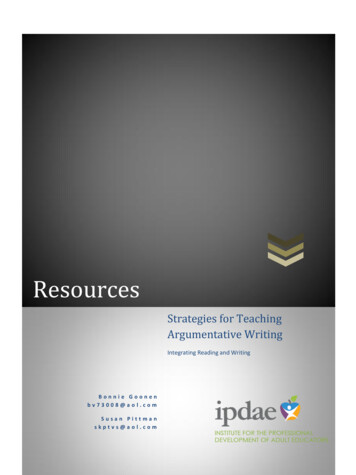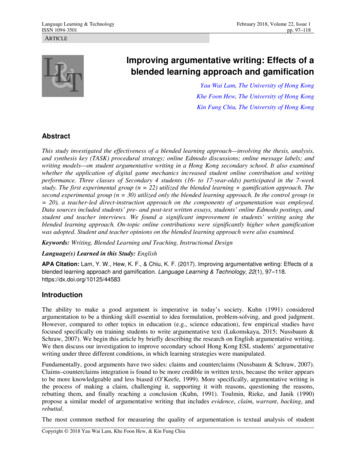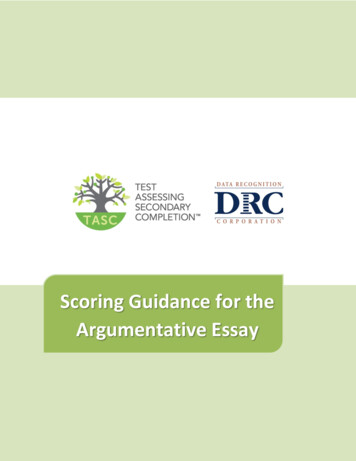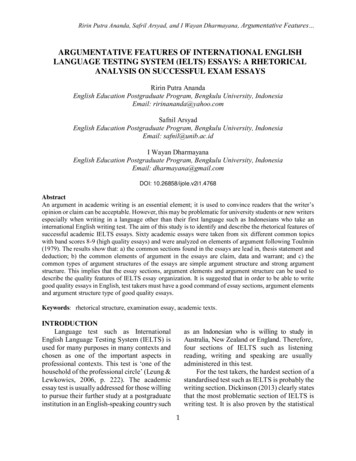
Transcription
ResourcesStrategies for TeachingArgumentative WritingIntegrating Reading and WritingBonnie Goonenbv73008@aol.comSusan Pittmanskptvs@aol.com
Response 7NotesFrom the “The 2014 GED Test – Reasoning Through Language Arts(RLA) Extended Response Resource Guide for Adult Educators” p. 18The ClaimAlthough both positions are well organized and supported with several examples, the evidencesupporting the view against DST is more specific and thorough. Is it debatable?Is the focus narrowenough for thewriting required?Does it establishthe argument?Is it valid?The first position makes some valid points, ones that are sure to catchany reader's attention. The writer brings up expenses, safety, and crimerates, all of which are supposedly improved through the use of DST.However, the evidence he uses to support this claim seems general andThe Evidence outdated. In paragraph four, he mentions that one study took place in the 1970s. He also uses phrases such as "many studies" and "other studies." While the points he makes are interesting, there are nospecifics. One is left wondering just how outdated or reliable theseDoes it support theclaim?Does it includefacts or statistics?Does it includeexamples?Is it based on anexpert’s or thewriter’s personalopinion?studies are, and if they even apply to the average American. Had heThe Warrantused less generalized phrases, he may have sounded more convincing. The second position is much better supported, especially compared tothe somewhat lacking arguments of the previous position. The writer'sinformation is precise, and he seems to use more studies than the first Does it explain thepieces of evidence?Does it connectevidence to theclaim?Is it reasonable?Does it makeassumptions?Is it logical?author. While the first author used studies from the 1970s, this one mentions a study done in 2007. The specifics of each study alsoThe Counterclaimimprove the quality and seeming validity of the arguments made. The writer gives the states in which the studies were conducted and thereasons why the researches believed they got those results. Also, likethe first author, the issues of which he writes are ones that will catchthe reader's attention: energy consumption, safety, and confusion.While they are similar to those points brought up by the first writer, Does the writerinclude informationthat disagrees withthe original claim?Is it reasonable?What is theevidence thatsupports thecounterclaim?Page 1 of 17
this second position is far better supported through its organizationand attention to detail.The Rebuttal Does it explain whythe counterclaimdoes not work?What is theevidence used tosupport therebuttal?Page 2 of 17
Looking at StructureClassic Model for an ArgumentNo one structure fits all written arguments. However, argumentative writing consists of the followingelements. Below is a basic outline for an argumentative or persuasive essay.I.Introductory Paragraph – Set up Your ClaimYour introductory paragraph sets the stage or the context for the position for which you are arguing.The introduction should include a thesis statement that provides your claim (what you are arguingfor) and the reasons for your position on an issue.Your thesis: states what your position on an issue is usually appears at the beginning or ending of the introduction in a short essay should be clearly stated and should contain emphatic language (should, ought, must)II.Body of your Argument – Support Your ClaimA. Background Information – Lays the foundation for proving your argumentThis section of your paper gives the reader the basic information he or she needs to understandyour position.This section will often include: A summary of works being discussed A definition of key terms An explanation of key theoriesB. Reasons or Evidence to Support your ClaimAll evidence you present in this section should support your position. This is the focus of youressay. Generally, you begin with a statement that you back up with specific details or examples.Make sure to connect the evidence to the claim. The reader should be able to see that there is alogical, persuasive connection between the claim, reasons, and data (evidence). Depending onhow long your argument is, you will need to devote one to two well-developed paragraphs toeach reason/claim or type of evidence.Sample Format for Supporting Evidence Paragraph Topic Sentence: What is one item, fact, detail, or example you can tell your readers thatwill help them better understand your claim/paper topic? Your answer should be thetopic sentence for this paragraph. Introduce Evidence: Introduce your evidence either in a few words (As Dr. Brown states . .) or in a full sentence (To understand this issue. we first need to look at statistics). State Evidence: What supporting evidence (reasons, examples, facts, statistics, and/orquotations) can you include to prove/support/explain your topic sentence?Page 3 of 17
III.Explain Evidence: How should we read or interpret the evidence you are providing us?How does this evidence prove the point you are trying to make in this paragraph? Can beopinion based and is often at least 1-3 sentences.Concluding/Transitional Sentence(s): End your paragraph with a concluding sentencethat reasserts how the topic sentence of this paragraph helps up better understandand/or prove your paper’s overall claim and how it transitions to the next idea.Addressing the Opposite Side – Refute the ObjectionsAny well-written argument must anticipate and address positions in opposition to the one beingargued. Pointing out what your opposition is likely to say in response to your argument establishesthat you have thought critically about your topic. Addressing the opposite side actually makes yourargument stronger! Generally, this takes the form of a paragraph that can be placed either after theintroduction or before the conclusion. Often this is phrased as an opposing view and the refutationto the view.Sample Format for Supporting Evidence Paragraph Introduce the Counterargument – this could be one or more arguments against yourthesis State the Evidence – what evidence is provided in the text(s) Refute the Evidence – argue against the evidence and why the stance that you haveselected is the better supported Concluding/Transitional Sentence(s) – end the paragraph with information that reassertsyour position as a whole.IV.ConclusionThe conclusion should bring the essay to a logical end. However, your conclusion should not simplyrestate your introductory paragraph. Your conclusion should explain what the importance of yourissue is in a larger context. Your conclusion should also reiterate why your topic is worth caringabout. Some arguments propose solutions or make prediction on the future of the topic.Adapted from:Odegaard Writing and Research Center. http://www.depts.washington.edu/owrcPurdue OWL Writing Lab. https://owl.english.purdue.edu/owl/The Writing Center at UNC Chapel Hill. http://writingcenter.unc.edu/handouts/The Writer’s Workplace. Ed. Sandra Scarry and John Scarry. 6th ed. Boston: Thomson Wadsworth, 2008.Page 4 of 17
Sample Outline for an Argumentative WritingBeginning(Introduction)Hook –Explanation of Issue –Thesis/Position –Argument 1State argument –Explanation –Evidence/Analysis –Argument 2State argument –Explanation –Evidence/Analysis –Argument 3State argument –(optional)Explanation –Evidence/Analysis –Argument 4State argument –(optional)Explanation –Evidence/Analysis –RefutationState opposing argument –Explanation –Refutation –Ending (Conclusion)Restate thesis in a new way –Bring things to a solid close/Give your reader something to think about –Page 5 of 17
The 7 Cs of ArgumentationAdapted from Inquire: A Guide to 21st Century Learning (2012 ed.)— King, Erickson, SebranekWriter’s Inc.: A Student Handbook for Writing & Learning (1996 ed.)—Sebranek, Meyer, Kemper1. Consider the situation What is the topic? What is my purpose? Who is my audience? What action do I want my audience to take?2. Clarify your thinking What are you trying to prove? Why do you feel the way you do? What kind of proof do you have? Who will be affected by this?Teaching Writing Strategy: Students complete an organizer or outline, such as: a Pro/Con chart , a Toulminoutline, or a Think in Threes graphic organizer.3. Construct a claim (thesis statement) A claim is the position statement or the key point of your argument Three types of claims: claim of fact—state something is true or not true; claim of value—statesomething has or doesn’t have worth; claim of policy—assert something should or shouldn’t be done Claims may contain one or more reasons you will prove A claim should be written as one coherent sentence4. Collect evidence Facts Examples Definitions Comparison Statistics Experience Analysis Prediction Demonstration Expert opinions Anecdotes/Reflections/Observations QuotationsTeaching Writing Strategy: Students need to learn how to identify faulty logic. This is an appropriate place todiscuss faulty thinking.5. Consider key objections—Develop counter arguments Point out flaws/weaknesses in arguments on the other side List objectionsPage 6 of 17
Recognize or concede another viewpoint when claim has true weaknesses. This adds believability tooverall claim.Teaching Writing Strategy: Students need to learn concession starters—transitional phrases thatdemonstrate they understand the value of other viewpoints. These include:Sample Concession Starters/Transitional PhrasesEven thoughTo illustratePerhapsFor instanceAdmittedlyFor that reasonWhile it is true thatFurthermoreCertainlyIn other wordsNeverthelessOn the other handAs an exampleIn contrastFor this purpose6. Craft your argument Use logical appeals—facts, statistics, expert opinions, anecdotes, and examples Avoid appeals to fear or ignorance Use levels of evidence—a minimum of two pieces of evidence to support each reason7. Confirm your claim Conclude with a coherent restatement of main arguments Use a call to actionTeaching Writing Strategy: Students need to assess their writing by asking questions as they revise and edit,such as using an outline chart of questions that assess the claim.Page 7 of 17
Avoid Fallacies of Thinking—Use Logic!An argument is a chain of reasons, supported by evidence, that support a claim. Faulty logic means usingevidence that is fuzzy, exaggerated, illogical, or false. Be careful to avoid faulty logic when defending claims.Appeal to Ignorance—Claiming that since no one has ever proved a claim, it must be false. Shifts the burdenof proof onto someone else. “Show me one study that proves ”Appeal to Pity—Using excuses to ask for leniency. “Imagine what it must have been like ”Bandwagon or Appealing to a Popular Position—Appeals to everyone’s sense of wanting to belong or beaccepted. “Everyone believes it or does it so you should too.”Broad Generalization—Takes in everything and everyone at once and allows for no exceptions. Using wordslike “all” and “everyone” are too general. “Is this claim true for all of the people being discussed, or just forsome?”Circular Thinking—Restating your claim in different words as evidence for your claim. “I hate this classbecause I’m never happy in this class.”Either-Or Thinking—Offering evidence that reduces examples to two possible extremes. “Are there otherpossibilities that should be considered?”Half-Truths—Telling only part or half of the truth. “Is this the full story—or is there another side to this thatis not being told?”Oversimplification—Simplifying complex topics into a “simple question.” “ is a simplequestion of .”Slanted Language or Distracting the Reader—Selecting words that have strong positive or negativeconnation in order to distract the reader from valid arguments. “Is this evidence dealing with the real issue?”“No one in his right mind would ever do anything that dumb.”Testimonial—Make sure the expert opinion is an authority on the topic. “What are this person’scredentials?”Exaggerating the Facts—“Is everything that is being said true and accurate?”Using a False Cause—Making a direct link between two separate things without evidence to back it up. “Is itfair to assume that the cause of the problem is exactly what the writer says, or might there be completelydifferent causes?”If Only Thinking—Using evidence that cannot be tested. “How does the writer know this would havehappened? Is there other evidence, or it is simply an ‘if only’ argument?”Page 8 of 17
Assessing the ClaimResponseNotesThe Claim Is it debatable? Is the focus narrow enough for thewriting required? Does it establish the argument? Is it valid?The Evidence Does it support the claim? Does it include facts or statistics? Does it include examples? Is it based on an expert’s or the writer’spersonal opinion?The Warrant Does it explain the pieces of evidence? Does it connect evidence to the claim? Is it reasonable? Does it make assumptions? Is it logical?The Counterclaim Does the writer include informationthat disagrees with the original claim? Is it reasonable? What is the evidence that supports thecounterclaim?The Rebuttal Does it explain why the counterclaimdoes not work? What is the evidence used to supportthe rebuttal?Page 9 of 17
Graphic Organizers for Argumentative WritingVee Charts as PrewritesPosition OnePosition TwoIssue:My ClaimPage 10 of 17
Argumentative Writing Organizers: Pros and ConsQuestion or StatementPros(Evidence that SupportsCons(Evidence that opposes)Decision for a claim:Defend your decision:Page 11 of 17
Argumentative Essay Graphic Organizer (Toulmin Model)Writing Prompt:Topic or Issue:Purpose:Audience:My CLEAR POSITION (thesis/claim) on the position:“Reasons” or WHY I take this positionEXAMPLES and EVIDENCE1.1.2.2.3.3.Most Significant CounterargumentRebuttals to CounterargumentsPage 12 of 17
Prewriting Organizer: Toulmin Model for ArgumentationA Claim:is your pointIs debatableIs demonstrated by reason and logicThesis/Claim Statement:Warrants: Just like a searchReasonwarrant from the police, theargument warrant gives the writerauthority to proceed with his/herargument. is the assumption thatmakes your claim plausible questions the evidence shows a logical, persuasiveconnection betweenclaim, reasons, data(evidence) gives authority to proceedwith your argument can be stated, but usuallyis assumedREFUTEReasonReasonReasonConclusionPage 13 of 17
Constructed Response OrganizerPrompt/Question:Restatement ofquestion in ownwordsSample answerText 1Text 2ClaimRebuttalEvidenceDetailed body ofevidence thatsupports answer besure to includeenough details toanswer the question.Make sure that alldetails address thequestions and arenot off-topic.Counterargument(s)Restated questionConcluding thoughtsPage 14 of 17
Extended Response Answer Guidelines – RLA TestPlease use the guidelines below as you answer the Extended Response question onthe Reasoning Through Language Arts test. Following these guidelines as closely aspossible will ensure that you provide the best response.1. Please note that this task must be completed in no more than 45 minutes.However, don’t rush through your response. Be sure to read through the passage(s)and the prompt. Then think about the message you want to convey in yourresponse. Be sure to plan your response before you begin writing. Draft yourresponse and revise it as needed.2. As you read, think carefully about the argumentation presented in the passage(s).“Argumentation” refers to the assumptions, claims, support, reasoning, andcredibility on which a position is based. Pay close attention to how the author(s)use these strategies to convey his or her positions.3. When you write your essay, be sure to: determine which position presented in the passage(s) is better supported byevidence from the passage(s) explain why the position you chose is the better-supported one remember, the better-supported position is not necessarily the positionyou agree with defend your assertions with multiple pieces of evidence from the passage(s) build your main points thoroughly put your main points in logical order and tie your details to your main points organize your response carefully and consider your audience, message, andpurpose use transitional words and phrases to connect sentences, paragraphs, andideas choose words carefully to express your ideas clearly vary your sentence structure to enhance the flow and clarity of your response reread and revise your response to correct any errors in grammar, usage, orpunctuationRetrieved from the World Wide Web 74e3cf83a8cae5b05e5627fd2754e87f.pdfPage 15 of 17
Revising and Editing ChecklistIntroduction Does your introduction begin with a sentence that grabs the reader’s attention? Does your paper contain a thesis that is a clear summary of your main point or argument? Is your thesis arguable? Your thesis should not simply be the statement of a fact because astatement is NOT arguable. Does your thesis match your assignment? A thesis for a compare-contrast paper isconstructed differently than a thesis for a personal narrative or a research paper. Is your thesis placed correctly? Normally the thesis should be the last sentence of yourintroductory paragraph, but it can also appear either as the first sentence or within the firstparagraph. Does your thesis provide a clear outline for the entirety of your paper? Does your thesis answer a question? Keep in mind, a thesis should never be written as aquestion.Body Paragraphs Does the topic sentence of each body paragraph summarize the entirety of the points thatparagraph covers? Does each topic sentence correspond with your thesis statement? Does all of the information in your paragraph support your topic sentence? Is the final sentence in each body paragraph a sentence that either summarizes theparagraph or transitions to the next point? Do you acknowledge an opposing point of view and then explain why you think it isn’t strongenough to change the point of view selected?Conclusion Does the last paragraph remind readers of the main points of the essay, without going into toomuch detail repeating everything readers just read? Is the conclusion free of new information (such as another supporting point)? Does the last sentence leave readers with a strong final impression?Entire PaperGeneral Is the writing in formal, third person? Does one idea flow smoothly into the next? Do the sentence structures and lengths vary? Does every sentence relate to the thesis? Does everything make sense? Is the essay convincing? Are the grammar, punctuation, and spelling correct?Page 16 of 17
Sentence Composition Have you removed unnecessary hedges that weaken your arguments such as probably,might be, somewhat, or kind of? Have you removed unnecessary words that do not add to the sentence such as really or alot? Have you varied your vocabulary by utilizing a thesaurus and dictionary when necessary inorder to avoid repetition or incorrect word choices? Are your sentences of varied lengths and complexities? A paper is stronger when it has amixture of sentences versus all short sentences or all long sentences. Are all transitions from one idea to another smooth and clearly explained, so the reader doesnot need to make any leaps in logic? Has all slang and conversational language been removed? Have you removed any offensive language, such as gender-based or biased language?Verbs Do your verb tenses match? Are your verb tenses consistent? Have you replaced unnecessary to be‟ verbs (be, been, is, are, were, was) with strongerverbs? Are you using “active‟ verbs?Integration of Information Are all of your quotes and paraphrases correctly cited? Are all of your quotes introduced and explained properly? Is all of your information, such as quotes and data, pertinent to your topic? Does yourinformation correspond with the topic sentence of your current paragraph?Grammar and Mechanics Have you used parallel structure? Do your pronouns agree with the antecedents they are replacing? Is your paper free of fragments and run-on sentences? Is your paper properly punctuated? Is your paper free of spelling errors? Have you read through your paper (slowly) in order to catch errors that you would missotherwise?Page 17 of 17
should be clearly stated and should contain emphatic language (should, ought, must) II. Body of your Argument – Support Your Claim A. Background Information – Lays the foundation for proving your argument This section of your paper gives the reader the basic










